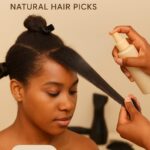
You know that feeling when you leave the salon and your hair looks glossy, smooth, bouncy, shaped, and you swear you’re going to recreate it at home this time. Then you try, and you either get flat root, frizz halo, crunchy curls, or ends that look a little cooked.
This guide is here for that exact moment. We’re talking practical routines for women with real hair, real humidity, real time limits. Not “just get a Dyson.” The question you should be asking is not “what’s the magic tool,” it’s “how do I get the finish I want without frying my hair over time.”
We’re going to walk through three common goals. One, smooth blowout that looks intentional, not puffy, whether you have fine hair that collapses fast or thick hair that never wants to lay flat. Two, soft curls that hold without going crispy, crunchy, or stiff. Three, frizz control and shine that doesn’t feel greasy or heavy.
We’ll also talk where heat tools actually fit into healthy styling and where you can fake the look with lower heat or better prep. Throughout, we will point you to deeper breakdowns like Shark SpeedStyle Pro Flex Hair Dryer Review, Best Flat Irons for Fine Hair That Don’t Sizzle, and more so you can pick what matches your hair type, not just what went viral.
Can You Get Salon Finish Without Wrecking Your Hair?
Short answer, yes, but only if you stop thinking “blast high heat until it’s straight” and start thinking “control the shape in stages.” Stylists talk about tension, direction, and finish. That’s what you’re recreating.
Heat is not the villain by itself. Repeated high heat on already stressed hair is the villain. That’s why lower temperature tools built around steady, controlled heat are such a big deal in stylist commentary. A good example is the ghd Chronos Styler Review: Speed, Shine, and Safer Heat At 365°F, which focuses on consistent, salon style smoothing at a set temperature instead of that orange level 450 degree blast that a lot of flat irons still treat as normal.
Airflow matters too. Faster controlled air cuts dry time, which means less exposure overall. The Shark SpeedStyle Pro Flex Hair Dryer Review gets into this idea of salon style airflow and attachments that help shape and smooth instead of just blowing hair everywhere. Faster dry with less chaos means less brushing, less yanking, less frizz.
So yes, you can get that polished look. But it is not about max heat. It’s about sectioning, gentler passes, smart prep, and finishing the hair cuticle so it actually stays down once you’re done.
Smooth Blowout At Home, Based On Hair Type
A smooth blowout does not mean “pin straight.” The goal is controlled volume at the root, softer ends, and no fuzzy halo around the head. How you get there changes based on your density.
For fine or flatter hair that gets oily fast, you want lift at the root without weighing it down. Use a light protectant and primer that gives slip but not grease. Color care leave-ins that protect and detangle without heaviness can help here, especially on color-treated hair that frizzes easily at the ends. The Pureology Color Fanatic Leave-In Spray Review breaks down how a lightweight leave-in can calm frizz, add heat protection, and help the brush glide without turning your hair limp. When you blow dry, aim the airflow downward along the hair shaft and roll sections up and away from the face with a round brush. You’re basically training a smooth bend, not flattening the life out of it.
For thick or high density hair, the problem is usually bulk, not oil. You want control and shine so it looks intentional, not huge. Wide sections and weak airflow are your enemy here. You will get less frizz if you work in smaller sections with steady tension and use a brush that can actually move through your density without snapping ends. The Best Hair Brush for Thick Hair guide looks at brushes that reduce snagging so you are not ripping through knots just to get the dryer through. Pair that with a strong, directional dryer setup like the one described in Shark SpeedStyle Pro Flex Hair Dryer Review, and you can smooth the cuticle while you dry instead of fighting frizz afterward.
Traveling or doing this in a shared bathroom and you do not want to haul a big dryer and round brush everywhere. The Best Travel Hair Dryers That Dry Fast rundown focuses on compact dryers built to actually dry thick or wavy hair quickly instead of just heating it up and leaving it half damp. Faster dry on vacation or in a hotel matters, because leaving the hair half damp and then blasting a flat iron over it is exactly how you get long term heat damage.
Key mindset for a salon style blowout at home. Dry in sections, guide the ends under or out on purpose, and seal down the cuticle with direction and tension, not with a final scorched flat iron pass on max temp.
Soft Curls Without Crispy Ends
If you’re going for curls or waves, you want definition that still moves. What ruins this at home is usually too much heat or the wrong product texture.
Let’s start with heat. A lot of flat irons and curling wands are way hotter than they need to be. Repeated passes at 400 plus degrees on the same section will absolutely dull the cuticle and give you that burned dry look at the ends, especially on highlighted or bleached hair. The Best Flat Irons for Fine Hair That Don’t Sizzle guide is built around finding irons that smooth and curl at safer temps for hair that can’t handle abuse. Lower, consistent heat is not just a marketing line. It’s what keeps your ends from getting scratchy.
If you struggle with technique on traditional wands, automated or guided curlers can help you get uniform curl without clamping too hard or overheating one spot. The CHI Spin N Curl Curling Iron Review walks through a style tool that basically feeds a section in and curls it for you at a set temp. Consistent curl shape, less guesswork, less frying.
If you like a looser, brushed out wave and you want tool flexibility, the Paul Mitchell Pro Tools Express Ion Unclipped 3-in-1 Curling Wand Review covers a multi barrel approach. The idea there is picking the barrel that gives the curl pattern you want instead of forcing tight spirals and then brushing them out aggressively, which can shred the ends. Bigger barrel for soft bends is gentler than tight barrel plus aggressive comb-out.
Now, product. Crunchy ends are almost always product related. Too much alcohol heavy spray on the ends, too much stiff gel, or mousse that isn’t meant for definition. A lighter hold foam can help define curl or wave pattern while keeping softness. The Best Hair Mousses for Curls That Define guide focuses on mousses built for definition and touchable hold instead of that wet look shell. If your curls are frizzing apart by lunch, it’s usually because they never had controlled slip and hold in the first place, not because your hair “can’t curl.”
One more finishing move. After curls cool completely, do one gentle rake or shake with your fingertips. Do not rip through with a paddle brush. Breaking curls too soon turns definition into frizz and makes you think you need more heat next time. You don’t. You just need patience in the cool-down step.
Frizz Control and Finishing Shine Without Buildup
This part is where salon hair really separates from at home hair. In the salon, they always finish you. They smooth the surface and make it look expensive. At home we tend to stop at “it’s dry.”
Frizz is mostly raised cuticle. Raised cuticle happens from rough drying, humidity, color damage, and old ends that won’t seal. Shine comes from laying the cuticle back down and keeping it there without suffocating the hair.
Leave-in protectants with light conditioning can help seal frizz before it even starts. The Pureology Color Fanatic Leave-In Spray Review is a good example of this type of product in color treated hair. It supports heat protection, softness, and a smoother surface in one step so you are not layering five things. That matters because layering five things usually equals buildup at the root and dull, waxy ends.
A finishing cream on the mid-lengths and ends can help stop static and flyaways without turning hair greasy. This is where salon stylists reach for soft shine creams that add polish and slip. The logic is similar to what you see in luxury blowout creams. You apply a pea sized amount to the very ends only, warm it in your palms first, and swipe it over visible fuzz. You’re not glazing your scalp.
If you like a little scent and “expensive hair” vibe, light fragrance mists made for hair can be helpful as long as they are not alcohol bombs. The Best Hair Perfume Mists That Won’t Dry Out breakdown looks at hair-safe mists that add that salon glossy finish and scent without drying your ends out. Key point. You mist from a little distance and aim mid-length down, not roots. Root perfume is just buildup plus irritation.
If you are in humidity or you know you frizz in 30 minutes no matter what you do, consider sealing your look with controlled, lower temp smoothing to lock in the cuticle. That is where tools that hold a steady, safer temperature like in ghd Chronos Styler Review can help you do one slow, gentle pass just on the surface to seal and lay flyaways, instead of a full re-flat iron session from root to end at high heat.
The theme here is finish the style. Do not just stop at dry and hope.
Final Thoughts
Salon hair is not magic. It’s process. Prep for slip and protection, shape in controlled sections, finish the cuticle so it stays how you put it. If you chase results instead of chasing max heat, you get better hair that actually lasts more than an hour.
You do not need every expensive tool on social media. You do, however, need the right category of tool for your hair density and your goal that day. Fast controlled airflow for smooth blowouts. Lower temp, consistent curl hardware for soft waves. Light leave-in and surface polish for frizz and shine.
The payoff is not just “pretty today.” It’s that your ends are still attached six months from now. You can get salon style finishes at home without wrecking your hair. You just have to treat heat as shaping, not punishment.
See Also
If you want that smooth, glossy salon finish without frying your hairline, start with airflow and tension control. The Shark SpeedStyle Pro Flex Hair Dryer Review breaks down fast drying and smoothing attachments that help shape hair while you dry so you fight less frizz later. Pair that with the brush types in Best Hair Brush for Thick Hair if you’ve got dense, high volume hair that tends to puff instead of lay flat. If you’re working with finer, more delicate strands or breakage-prone highlights, read Best Flat Irons for Fine Hair That Don’t Sizzle before you grab a straightener, because steady moderate heat is what keeps ends from going rough and split.
For curls and wave definition instead of frizz and crunch, the styling breakdowns in Best Hair Mousses for Curls That Define and the tool technique in ghd Chronos Styler Review: Speed, Shine, and Safer Heat At 365°F explain how to get bounce and shine with touchable movement. Use those as your next step if you’re trying to build a weekly routine that still looks intentional by school pickup or date night, not just for selfies right after styling.
FAQs
Do I need a $500 dryer to get a smooth blowout at home?
Not always. What matters more is controlled airflow, the right attachment, and working in sections with tension. The approach in Shark SpeedStyle Pro Flex Hair Dryer Review focuses on speed plus smoothing, which cuts frizz without blasting high heat for ten minutes straight.
Why does my hair look good for 20 minutes, then frizz up?
Usually the cuticle was never sealed. Humidity gets in and lifts it. A controlled finishing pass with a consistent temp tool like the one in ghd Chronos Styler Review: Speed, Shine, and Safer Heat At 365°F, plus a light leave-in like in Pureology Color Fanatic Leave-In Spray Review, can help lock things down longer.
How do I get curls that aren’t crunchy or stiff?
Lower temp curling, correct barrel size, and flexible hold products. The techniques in CHI Spin N Curl Curling Iron Review and flexible stylers from Best Hair Mousses for Curls That Define are built around soft definition instead of helmet hair.
My hair is thick and just turns huge when I blow dry it. What am I doing wrong?
You’re probably drying too fast with no tension or using the wrong brush. Work in smaller sections and use a brush that can actually glide through dense hair without tearing. The picks in Best Hair Brush for Thick Hair are designed for that. Direct the airflow down the strand to smooth the cuticle instead of blasting air everywhere.
Is daily heat automatically bad?
Daily high heat at max temp on already stressed hair is bad. Strategic, moderate heat on fully dry hair with protection is a different story. That’s why safer-temp tools like in Best Flat Irons for Fine Hair That Don’t Sizzle and leave-ins like in Pureology Color Fanatic Leave-In Spray Review exist. It’s not “never use heat.” It’s “use heat like finishing, not punishment.”




